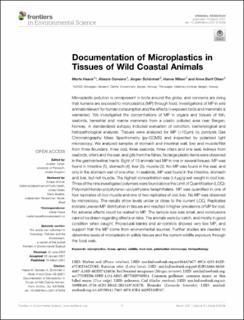| dc.description.abstract | Microplastic pollution is omnipresent in biota around the globe, and concerns are rising that humans are exposed to microplastics (MP) through food. Investigations of MP in wild animals relevant for human consumption and the effects in exposed birds and mammals is warranted. We investigated the concentrations of MP in organs and tissues of fish, seabirds, terrestrial and marine mammals from a plastic polluted area near Bergen, Norway. A standardized autopsy included evaluation of condition, bacteriological and histopathological analyzes. Tissues were analyzed for MP (>10 μm) by pyrolysis Gas Chromatography Mass Spectrometry (py-GCMS) and inspected by polarized light microscopy. We analyzed samples of stomach and intestinal wall, liver and muscle/fillet from three flounders, three cod, three seabirds, three otters and one seal, kidneys from seabirds, otters and the seal, and gills from the fishes. No large plastic items were observed in the gastrointestinal tracts. Eight of 13 animals had MP in one or several tissues. MP was found in intestine (5), stomach (4), liver (3), muscle (3). No MP was found in the seal, and only in the stomach wall of one otter. In seabirds, MP was found in the intestine, stomach and liver, but not muscle. The highest concentration was 3.4 μg/g wet weight in cod liver. Three of the nine investigated polymers were found above the Limit of Quantification (LOQ): Polyvinylchloride>polystyrene>>polyethylene terephthalate. MP was quantified in one of four replicates of cod muscle and one of two replicates of cod liver. No MP was observed by microscopy. The results show levels under or close to the current LOQ. Replicates indicate uneven MP distribution in tissues and resulted in higher prevalence of MP for cod. No adverse effects could be related to MP. The sample size was small, and conclusions cannot be drawn regarding effects or risks. The animals were by-catch, and mostly in good condition when caught. Procedural blanks and air-controls showed very low MP, and support that the MP come from environmental sources. Further studies are needed to determine levels of microplastic in edible tissues and the current wildlife exposure through the food web. | |

